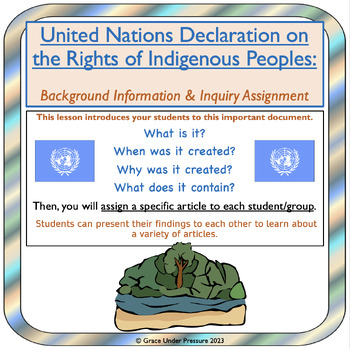United Nations Declaration on the Rights of Indigenous Peoples (UNDRIP) Inquiry
- PDF
- Easel Activity
Description
This lesson introduces your middle school students to the United Nations Declaration on the Rights of Indigenous Peoples (UNDRIP): an important global document that codifies the specific human rights of indigenous peoples all over the world.
1) The first worksheet helps guide students in answering the following questions:
- What is it?
- When was it created?
- Which countries opposed it initially?
- Why was it created?
- What does it contain?
You can fill in the first page of questions together as a class, or get students to research it on their own or in small groups.
2) Then, you will assign a specific article from the United Nations Declaration on the Rights of Indigenous Peoples to each student/group.
I would recommend looking at the articles ahead of time and choosing ones that will be salient to your students and manageable to find examples for.
Land rights, education, ceremonies, and language would all be good choices.
Students will research what their assigned article means and find examples of when it was broken (historically or modern) and when it was upheld since the UNDRIP was adopted.
3) There is a sample assignment included (Article 25) to model this task for your students. It includes two news reports that show when Article 25 was upheld and when it was broken. The examples can be from Indigenous Peoples from any country (Canada, the USA, Australia, New Zealand, etc.)
You can teach a mini-lesson about internet search terms if students need support finding examples for this section. For example, they could search "indigenous peoples" along with a few key words from their specific article to find examples. They may also be able to think of examples from previous lessons or find them in their textbooks (i.e residential schools, banning the Potlatch, and the creation of new First Nations Health Authorities).
4) Students can present their findings to each other to learn about a variety of articles in the UNDRIP.
What's Included 5 Page PDF Ready to Print and Use
- Title Page/Teacher Instructions
- Worksheet with questions about UNDRIP
- Sample Activity: to show students how to do the assignment
- Graphic Organizer: for students to research their assigned article
- Worksheet ANSWER KEY






